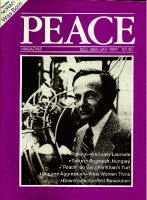
Peace Magazine Dec 1986-Jan 1987, page 40. Some rights reserved.
Search for other articles by Barry Stevens here
Reviewed by Barry Stevens
PEACE Magazine asked Rear Admiral Eugene Carroll, U.S. Navy (ret.), who is the Deputy Director the Center for Defense Information, an aviator, and the former commander of the aircraft carrier Midway, to review the movie Top Gun. He said if he sat through it, he'd probably throw up. So I took the assignment; I have a strong stomach.
Top Gun is a big budget, major studio film about the pilots of the U.S. Navy. It has already attained the $100 million mark in gross box office receipts. Reportedly, Navy recruiting has skyrocketed. The story features the adventures of a man/boy named Maverick, played by Tom Cruise. Maverick is an F-14 pilot on one of the Navy's giant flattops. He gets to go to a school called Top Gun, to learn the "lost art" of dogfighting. The Navy helped the film by providing planes and pilots at cost. (After working on the picture, some of the pilots were on the Libya raid.) Their expertise did not rub off on the script. There is precious little of the high technology--just the hero gunning his engines and waggling his joystick while his partner yells "Look out!." (Actually, that may be fairly accurate. Although the high-tech toys can tell a pilot where a plane is, he often can't fire until he has confirmed visually that it is an enemy. Trouble is, the enemy will have fired by then too and so both pilots get killed. But you don't want to spoil a recruiting film with that.)
Maverick has a buddy who is less sexually potent (he's married) and less talented but likeable, and therefore he has to die. This provokes a crisis of will in the hero, only resolved when he learns that his father really was doing good in Vietnam. In movies, the crisis of will cliché usually is manifested by the hero's own Vietnam flashbacks that he has to overcome--e.g. Firefox, First Blood, Blue Thunder. Top Gun is the first son-of-Vietnam picture. But the message is the same: The U.S. has to overcome its guilt over Vietnam, which is crippling its will to fight.
And fight it does. The most interesting thing about the film is the way it treats the military relationship with the USSR. Two encounters with Soviet warplanes frame the movie. The one at the beginning arises because the F-14s scramble to challenge some MiGs that are in the same area of ocean as the aircraft carrier. They come close to combat with an air of happy-go-lucky brinksmanship. The assumption behind this scene is that any plane within the striking range of a carrier is entering into U.S. territory. But the climactic encounter is more amazing still. A U.S. spy ship has become crippled and has drifted into the territorial waters of a nation unfriendly to the United States. Soviet planes are in the area. The F-14s are told to fire on the Russians if they interfere with the rescue operation. So instead of dealing with the situation diplomatically, the Navy illegally enters foreign territory and blows up MiGs. Much cheering and hugging.
Of course, it's just a movie. But there is an odd interaction between art and life. Is it a coincidence that the major threat to an arms deal and, indirectly, our lives, is named after the highest grossing film series of all time? (Ironically, the last of the Star Wars films ended with happy teddy bears hugging each other and dancing as their enemies were incinerated in a thermonuclear explosion.)
Can it be that U.S. public policy more and more is molded to fit the images of film and television, because that is the language voters understand? If this is true, films like Top Gun are as deadly as a failed summit.

Peace Magazine Dec 1986-Jan 1987, page 40. Some rights reserved.
Search for other articles by Barry Stevens here